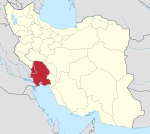Khorramshahr
Khorramshahr
خرَمشَهر | |
|---|---|
City | |
 | |
 Khorramshahr | |
| Coordinates: 30°26′23″N 48°09′59″E / 30.43972°N 48.16639°ECoordinates: 30°26′23″N 48°09′59″E / 30.43972°N 48.16639°E | |
| Country | |
| Province | Khuzestan |
| County | Khorramshahr |
| Bakhsh | Central |
| Population (2016 census) | |
| • Total | 135,328 |
| Time zone | UTC+3:30 (IRST) |
| • Summer (DST) | UTC+4:30 (IRDT) |
Khorramshahr (Persian: خرمشهر [xoræmˈʃæhɾ], also romanized as Khurramshahr, Arabic: المحمرة, romanized as Al-Muhammerah)[1][2] is a city and capital of Khorramshahr County, Khuzestan Province, Iran. At the 2016 census, its population was 170,976, in 47,380 households.[3]
Khorramshahr is an inland port city located approximately 10 kilometres (6.2 mi) north of Abadan. The city extends to the right bank of the Shatt Al Arab waterway near its confluence with the Haffar arm of the Karun river. The 1986 census proved that as a result of the Iran-Iraq War, the city was poorly-populated. However more recent censuses show that the population has returned to its approximate pre-war level.
History[]
The area where the city exists today was originally under the waters of the Persian Gulf. It later became part of the vast marshlands and the tidal flats at the mouth of the Karun River. The small town known as Piyan, and later Bayan appeared in the area no sooner than the late Parthian time in the 1st. Century AD. Whether or not this was located at the same spot where Khurramshahr is today, is highly debatable.
During the Islamic centuries, the Daylamite Buwayhid king, Panah Khusraw Adud ad-Dawlah ordered the digging of a canal to join the Karun River (which at the time emptied independently into the Persian Gulf through the Bahmanshir channel) to the Shatt al-Arab (the joint estuary of the Tigris and Euphrates rivers, known in Iran as Arvand Rud). The extra water made the joint estuary more reliably navigable. The channel thus created was known as the Haffar, Arabic for "excavated," "dugout," which exactly described what the channel was. The Haffar soon became the main channel of the Karun, as it is in the present day.
Until 1847, at which time it became Persian territory (according to Article II of the Treaty of Erzurum), Khorramshahr was alternately claimed and occupied by Persia and Turkey. Its ruler at the time was an Arab sheikh.[4]
Iran–Iraq War[]
Because of the war, the population of Khorramshahr dropped from 146,706 in the 1976 census to 0 in the 1986 census. The population reached 34,750 in the 1991 census and by the 2006 census it reached 123,866, and according to World Gazetteer its population as of 2012 is 138,398, making the population close to what it was before the war.[5]
Notable people[]
- Majid Bishkar (b. 1956), Iranian football legend, played at the 1978 FIFA World Cup[6]
- Mohsen Rastani (b. 1958), Iranian photographer, photojournalist[7]
References[]
- ^ Khorramshahr can be found at GEOnet Names Server, at this link, by opening the Advanced Search box, entering "-3071225" in the "Unique Feature Id" form, and clicking on "Search Database".
- ^ Khorramshahr entry in Encyclopædia Britannica http://www.britannica.com/EBchecked/topic/316878/Khorramshahr
- ^ https://www.amar.org.ir/Portals/1/census/2016/results/detailed/country/population/table-09_census2016_population-detailed-country.xlsx
- ^ One or more of the preceding sentences incorporates text from a publication now in the public domain: Chisholm, Hugh, ed. (1911). "Muhamrah". Encyclopædia Britannica. 18 (11th ed.). Cambridge University Press. p. 956.
- ^ "Census of the Islamic Republic of Iran, 1385 (2006)" (Excel). Statistical Center of Iran. Archived from the original on 2011-11-11.
- ^ "Majid Bishkar: The 'Prince of Persia' who cast a spell with his magic". East Bengal Football Club official website. Retrieved 1 July 2021.
- ^ "Mohsen Rastani". Qoqnoos. Archived from the original on 22 June 2013.
External links[]
- Populated places in Khorramshahr County
- Cities in Khuzestan Province
- Port cities and towns in Iran
- Former ghost towns

